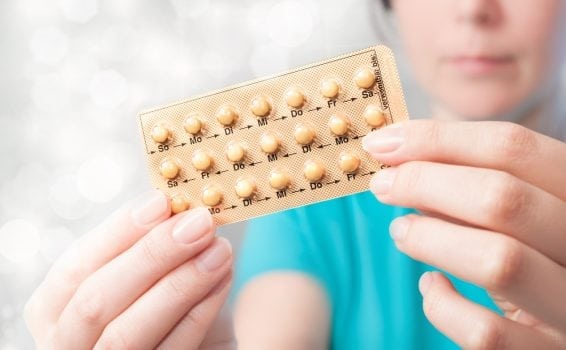Testosterone is a sexual and reproductive hormone. Though chiefly considered a male hormone, small concentrations of testosterone are produced by a woman’s ovaries and adrenal glands. In this article we will examine testosterone, the role it plays in a woman’s body, the medical conditions that might precipitate a chemical imbalance of testosterone in women and potential treatment methods women can employ to promote healthy testosterone levels.
What Functions Does Testosterone Perform Inside a Woman’s Body?
 Testosterone is key to the development of a woman’s physique, as it helps build strong bones and muscles and prevents the accumulation of body fat. However, stimulation of the sex drive is arguably the most important impact testosterone has on women. Not only is testosterone believed to enhance a woman’s sexual urges but is also thought to sensitize sexual regions like the clitoris and nipples, which can heighten the sexual experience.
Testosterone is key to the development of a woman’s physique, as it helps build strong bones and muscles and prevents the accumulation of body fat. However, stimulation of the sex drive is arguably the most important impact testosterone has on women. Not only is testosterone believed to enhance a woman’s sexual urges but is also thought to sensitize sexual regions like the clitoris and nipples, which can heighten the sexual experience.
What Causes an Imbalance of Testosterone in Women?
There are numerous conditions that might elicit both elevated and decreased levels of testosterone. Some of the most common causes of an testosterone imbalance in women include:
Polycystic Ovary Syndrome (PCOS)
In Polycystic Ovary Syndrome, the ovaries cease to function properly. In some instances, the disease precipitates excessive production of male hormones called androgens, including testosterone.
Malfunctioning Adrenal Glands
The adrenal glands execute a crucial role in helping the body maintain hormonal balance. Damaged or diseased adrenal glands could lead to an increased bodily concentration of testosterone in women.
Imbalances of Other Hormones
When women experience hormonal imbalances of estrogen and progesterone, fluctuating levels of other hormones, like testosterone, could also result.
Obesity
Increased weight and excess fat increases testosterone production in women. However, obesity can further exacerbate the problem because fat cells might precipitate a condition called insulin resistance, a precursor to diabetes which is also known to affect testosterone concentrations.
An Underactive Thyroid Gland
This health condition, medically referred to as hypothyroidism, occurs when the thyroid gland releases insufficient levels of thyroid hormone. In addition, the thyroid plays a significant role in bodily hormone regulation. The end result could be increased testosterone production.
Physical Inactivity
Women who fail to exercise on a fairly regular basis may experience elevated blood sugar levels. Excess blood sugar can cause increased bodily concentrations of testosterone.
Pregnancy
It is not uncommon for the body to produce higher than normal levels of testosterone during pregnancy.
Age
As women grow older, their bodies produce diminished amounts of most hormones, including testosterone.
The Use of Contraceptive Drugs
 The birth control methods used by some women to prevent unwanted pregnancies may interrupt hormone production resulting in bodily deficiencies of substances such as testosterone.
The birth control methods used by some women to prevent unwanted pregnancies may interrupt hormone production resulting in bodily deficiencies of substances such as testosterone.
Removal of the Ovaries
Damage to the ovaries or certain medical conditions like cancer might necessitate removal of these vital sex organs. Removal of the ovaries typically precipitates a significant drop in testosterone levels.
Chronic Illnesses
The presence of long-standing, chronic ailments like diabetes, kidney disease, a malfunctioning thyroid and various immune system disorders could all lead to the development of low testosterone in women.
What Are the Symptoms of Testosterone Imbalance in Women?
Any condition that may create increased or diminished levels of testosterone will likely produce its own set of signs and symptoms. However, there are certain general occurrences that women experiencing a testosterone imbalance might experience.
Women stricken with a health condition that precipitates high levels of testosterone might experience symptoms like acne, irregular or interrupted menstrual cycles, excessive body hair, balding and abnormal muscle growth. Women with low testosterone may be afflicted with fatigue, painful intercourse, decreased sex drive, interrupted menstrual periods, disrupted sleep patters, weight gain, mental issues like anxiety, mood swings, depression and weakened bones.
Therapeutic Protocols For Testosterone Imbalance in Women
The first step in treating either excessive or diminished levels of testosterone is identifying the underlying cause. Once a woman and her doctor pinpoint the exact cause, several different treatment options exist.
Some women have found success in lowering their testosterone levels by using prescription drugs such as steroids and contraceptive preparations, losing weight, getting more exercise and making dietary changes. Low testosterone might be treated using hormone replacement therapy, by stopping the use of contraceptive drugs and through the ingestion of various natural nutritional supplements believed to boost testosterone. Certain natural or herbal formulas may also help maintain healthy hormone balance in women.
It is also important to mention that specific therapeutic protocols (for both increased and decreased testosterone levels) will likely be prescribed by a physician after considering certain factors specific to each individual patient such as her age, general health, in addition to the precipitating condition and its severity.

